See Page 1 |
2 |
3 |
4 | of the June 2024 homepage archives. Friday the 21st
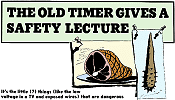 Jack Darr authored many pieces for Radio-Electronics
magazine. Most were monthly columns dealing with servicing and troubleshooting.
He also published a dozen or so book on electronics, like Eliminating Man-Made
Interference, Servicing Unique Electronic Apparatus, Transistor
Audio Amplifiers, and How to Test Almost Everything Electronic. Release
dates range from the 1960s through 2021 Mr. This article on safety
"best practices" when working on electrical and electronics equipment appeared
in a 1960 issue of Radio-Electronics. A lot of the danger back in the day
was attributable to poor design methods that did not properly isolate the line voltage
from exposed metallic surfaces. That included the chassis onto and into which components
were installed, hookup wires, and shafts for potentiometers, tuning capacitors,
and switches. The plugs on supply cords were not polarized... Jack Darr authored many pieces for Radio-Electronics
magazine. Most were monthly columns dealing with servicing and troubleshooting.
He also published a dozen or so book on electronics, like Eliminating Man-Made
Interference, Servicing Unique Electronic Apparatus, Transistor
Audio Amplifiers, and How to Test Almost Everything Electronic. Release
dates range from the 1960s through 2021 Mr. This article on safety
"best practices" when working on electrical and electronics equipment appeared
in a 1960 issue of Radio-Electronics. A lot of the danger back in the day
was attributable to poor design methods that did not properly isolate the line voltage
from exposed metallic surfaces. That included the chassis onto and into which components
were installed, hookup wires, and shafts for potentiometers, tuning capacitors,
and switches. The plugs on supply cords were not polarized...
 I usually try to post something a little
less serious and technical on Fridays to help everyone wind down from the long week
just passed. It could be a Carl & Jerry or a Mac's Radio Service Shop story,
an electronics quiz, or even something I found out on the Internet. This time it
is a "believe-it-or-not" type feature in a c1935 Radio-Craft magazine entitled
"Curiosa
in Radio," about radio manufacturing, operating, and infrastructure. One factoid
claims "Only 1.1% of set manufacturers in business in 1924 are building sets today."
It could due to being in the middle of the Depression Era so almost nobody was making
/ buying radios, but more likely it reflects the reality of the many people who
jumped into the fledgling radio industry early on and then could not gain market
share... I usually try to post something a little
less serious and technical on Fridays to help everyone wind down from the long week
just passed. It could be a Carl & Jerry or a Mac's Radio Service Shop story,
an electronics quiz, or even something I found out on the Internet. This time it
is a "believe-it-or-not" type feature in a c1935 Radio-Craft magazine entitled
"Curiosa
in Radio," about radio manufacturing, operating, and infrastructure. One factoid
claims "Only 1.1% of set manufacturers in business in 1924 are building sets today."
It could due to being in the middle of the Depression Era so almost nobody was making
/ buying radios, but more likely it reflects the reality of the many people who
jumped into the fledgling radio industry early on and then could not gain market
share...
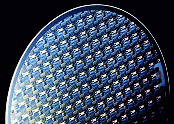 "Scientists have developed
GaN semiconductors to boost efficiency and reduce costs in electric vehicles
and renewable energy, aiding the energy transition. Key technologies crucial for
the energy transition - including electric vehicles, charging infrastructure converters,
energy storage systems, as well as solar and wind power plants -depend heavily on
electronic components that deliver both high performance and efficiency. Wide band
gap semiconductors are essential in these components' development because they operate
with lower losses, handle higher voltages, and tolerate greater temperatures compared
to traditional silicon-based (Si) semiconductors. The Fraunhofer Institute for Applied
Solid State Physics IAF uses the power semiconductor..." "Scientists have developed
GaN semiconductors to boost efficiency and reduce costs in electric vehicles
and renewable energy, aiding the energy transition. Key technologies crucial for
the energy transition - including electric vehicles, charging infrastructure converters,
energy storage systems, as well as solar and wind power plants -depend heavily on
electronic components that deliver both high performance and efficiency. Wide band
gap semiconductors are essential in these components' development because they operate
with lower losses, handle higher voltages, and tolerate greater temperatures compared
to traditional silicon-based (Si) semiconductors. The Fraunhofer Institute for Applied
Solid State Physics IAF uses the power semiconductor..."
 This
vector circuit matching quiz will hurt the brain a little more than most of
the ones that were printed in Popular Electronics magazine. In order to
score well, it helps to visualize the circuits relative to where they would appear
on a Smith Chart. Capacitive impedances lie in the bottom half and have negative
phases (-s, -jω). Inductance lie in the upper half and have positive phases (s,
jω). The familiar "ELI the ICE man" mnemonic helps, too. Be sure to pay attention
to the color of the vector arrow heads. Example: In a purely inductive circuit like
#4, voltage leads current by 90°. Since phase rotation is CCW, you need to look
for lettered phase diagram where the white arrowhead (voltage) is 90° ahead of the
black arrow head (current), going in the CCW direction. Vector diagram letter "H"
looks like that. Circuit #10, being purely capacitive, is just the opposite, so
its vector diagram... This
vector circuit matching quiz will hurt the brain a little more than most of
the ones that were printed in Popular Electronics magazine. In order to
score well, it helps to visualize the circuits relative to where they would appear
on a Smith Chart. Capacitive impedances lie in the bottom half and have negative
phases (-s, -jω). Inductance lie in the upper half and have positive phases (s,
jω). The familiar "ELI the ICE man" mnemonic helps, too. Be sure to pay attention
to the color of the vector arrow heads. Example: In a purely inductive circuit like
#4, voltage leads current by 90°. Since phase rotation is CCW, you need to look
for lettered phase diagram where the white arrowhead (voltage) is 90° ahead of the
black arrow head (current), going in the CCW direction. Vector diagram letter "H"
looks like that. Circuit #10, being purely capacitive, is just the opposite, so
its vector diagram...
 This assortment of custom-designed themes
by RF Cafe includes T-Shirts, Mouse Pads, Clocks, Tote Bags, Coffee Mugs and Steins,
Purses, Sweatshirts, Baseball Caps, and more, all sporting my amazingly clever "RF Engineers - We Are the World's
Matchmakers" Smith chart design. These would make excellent gifts for husbands,
wives, kids, significant others, and for handing out at company events or as rewards
for excellent service. My graphic has been ripped off by other people and used on
their products, so please be sure to purchase only official RF Cafe gear. I only
make a couple bucks on each sale - the rest goes to Cafe Press. It's a great way
to help support RF Cafe. Thanks... This assortment of custom-designed themes
by RF Cafe includes T-Shirts, Mouse Pads, Clocks, Tote Bags, Coffee Mugs and Steins,
Purses, Sweatshirts, Baseball Caps, and more, all sporting my amazingly clever "RF Engineers - We Are the World's
Matchmakers" Smith chart design. These would make excellent gifts for husbands,
wives, kids, significant others, and for handing out at company events or as rewards
for excellent service. My graphic has been ripped off by other people and used on
their products, so please be sure to purchase only official RF Cafe gear. I only
make a couple bucks on each sale - the rest goes to Cafe Press. It's a great way
to help support RF Cafe. Thanks...
Thursday the 20th
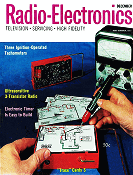 Radio-Electronics magazine founder,
editor, and publisher Hugo Gernsback wrote this "How
Far Amplification?" article in 1960. In it, he briefly discusses the history
of radio signal detection and amplification in the preceding 60 years, and then
projects what the state of the art might be 60 years henceforth. Relative to 1960,
that would be the year 2020, which is already four years old. In 1960, the electronics
world was transitioning from vacuum tubes to solid state devices, so vast improvements
in low noise and amplification factors were being made. Mr. Gernsback, the
remarkable futurist that he was, foresaw generally the extremely low noise figure
amplifiers of today, which enable higher levels of amplification before the signal-to-noise
ratio renders further amplification useless. Interestingly, he did not mention the
theoretical noise floor of -174 dBm/Hz, which except maybe for spread signal
communications imposes a fairly hard limit on how much amplification is useful.
At that level, an amplification factor of 10(174/10) = 1017.4
= 251 quadrillion, only gets the signal to 1 mW... Radio-Electronics magazine founder,
editor, and publisher Hugo Gernsback wrote this "How
Far Amplification?" article in 1960. In it, he briefly discusses the history
of radio signal detection and amplification in the preceding 60 years, and then
projects what the state of the art might be 60 years henceforth. Relative to 1960,
that would be the year 2020, which is already four years old. In 1960, the electronics
world was transitioning from vacuum tubes to solid state devices, so vast improvements
in low noise and amplification factors were being made. Mr. Gernsback, the
remarkable futurist that he was, foresaw generally the extremely low noise figure
amplifiers of today, which enable higher levels of amplification before the signal-to-noise
ratio renders further amplification useless. Interestingly, he did not mention the
theoretical noise floor of -174 dBm/Hz, which except maybe for spread signal
communications imposes a fairly hard limit on how much amplification is useful.
At that level, an amplification factor of 10(174/10) = 1017.4
= 251 quadrillion, only gets the signal to 1 mW...
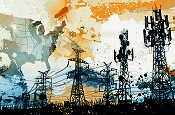 A
lot is happening in the world of
Citizens
Broadband Radio Service (CBRS). Now the FCC Chairwoman Jessica Rosenworcel wants
to kick off a proceeding to consider new rules for the band. Known in FCC parlance
as a Notice of Proposed Rulemaking (NPRM), the proceeding would seek comment on
a range of potential rule changes to improve the CBRS band for current and future
users. The 3.5 GHz CBRS band is unique to the U.S. and uses a three-tiered model
to protect Navy radar while allowing commercial use of the spectrum. “Cooperation
is critical for a successful spectrum future. We can preserve and enhance the Citizens
Broadband Radio Service to both protect progress and look ahead... A
lot is happening in the world of
Citizens
Broadband Radio Service (CBRS). Now the FCC Chairwoman Jessica Rosenworcel wants
to kick off a proceeding to consider new rules for the band. Known in FCC parlance
as a Notice of Proposed Rulemaking (NPRM), the proceeding would seek comment on
a range of potential rule changes to improve the CBRS band for current and future
users. The 3.5 GHz CBRS band is unique to the U.S. and uses a three-tiered model
to protect Navy radar while allowing commercial use of the spectrum. “Cooperation
is critical for a successful spectrum future. We can preserve and enhance the Citizens
Broadband Radio Service to both protect progress and look ahead...
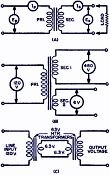 Basic
transformer circuits have not changed in the more than sixty years since this
article was published in Popular Electronics magazine. The applications
have definitely changed, though, since active circuits of the day required a relatively
low voltage (step-down) for vacuum tube cathode heaters, and at least one relatively
high voltage (step-up) for biasing the tube plate. Most transformers for today's
consumer applications perform a single step-down operation for 3.3 V, 5 V,
12 V, etc. In many applications, transformers are done away with altogether
in favor of solid state rectifiers and regulators. A 5-question quiz is provided
at the end. There is also a short tutorial on electrostatic speakers and some analog
and digital signal info... Basic
transformer circuits have not changed in the more than sixty years since this
article was published in Popular Electronics magazine. The applications
have definitely changed, though, since active circuits of the day required a relatively
low voltage (step-down) for vacuum tube cathode heaters, and at least one relatively
high voltage (step-up) for biasing the tube plate. Most transformers for today's
consumer applications perform a single step-down operation for 3.3 V, 5 V,
12 V, etc. In many applications, transformers are done away with altogether
in favor of solid state rectifiers and regulators. A 5-question quiz is provided
at the end. There is also a short tutorial on electrostatic speakers and some analog
and digital signal info...
 Anatech Electronics offers the industry's
largest portfolio of high-performance
standard and customized RF and microwave filters and filter-related products
for military, commercial, aerospace and defense, and industrial applications up
to 40 GHz. Three new ceramic filters have been announced for mid June 2024
- a 2595 MHz bandpass filter with a 50 MHz bandwidth and 1.5 dB insertion
loss, 2535 MHz bandpass filter with a 70 MHz bandwidth and 2.2 dB
insertion loss, and a 2437 MHz bandpass filter with a 14 MHz bandwidth
and 3.2 dB insertion loss. Custom RF power filter and directional couplers
designs can be designed and produced with required connector types when... Anatech Electronics offers the industry's
largest portfolio of high-performance
standard and customized RF and microwave filters and filter-related products
for military, commercial, aerospace and defense, and industrial applications up
to 40 GHz. Three new ceramic filters have been announced for mid June 2024
- a 2595 MHz bandpass filter with a 50 MHz bandwidth and 1.5 dB insertion
loss, 2535 MHz bandpass filter with a 70 MHz bandwidth and 2.2 dB
insertion loss, and a 2437 MHz bandpass filter with a 14 MHz bandwidth
and 3.2 dB insertion loss. Custom RF power filter and directional couplers
designs can be designed and produced with required connector types when...
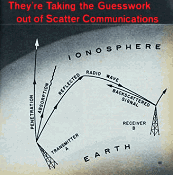 As with many areas of electronics communications,
much of both the initial and continued research in
atmospheric scattering of electromagnetic signals was/is done by amateur radio
operators. The phenomenon is routinely used for accomplishing long distance communications
(DX, in Ham terms) by exploiting the reflection property of ionized layers when
radio signals impinge at a certain angle. The portion of the signal that returns
to the transmitter location, when monitored, can provide information to the sender
about the height, distance, and frequency range of the reflecting atmospheric layer.
Some of the first indications of backscattering were noticed by radar operators
who would receive echo returns from "phantom" targets that were really atmospheric
reflections... As with many areas of electronics communications,
much of both the initial and continued research in
atmospheric scattering of electromagnetic signals was/is done by amateur radio
operators. The phenomenon is routinely used for accomplishing long distance communications
(DX, in Ham terms) by exploiting the reflection property of ionized layers when
radio signals impinge at a certain angle. The portion of the signal that returns
to the transmitter location, when monitored, can provide information to the sender
about the height, distance, and frequency range of the reflecting atmospheric layer.
Some of the first indications of backscattering were noticed by radar operators
who would receive echo returns from "phantom" targets that were really atmospheric
reflections...
 Banner Ads are rotated in all locations
on the page! RF Cafe typically receives 8,000-15,000 visits each
weekday. RF Cafe
is a favorite of engineers, technicians, hobbyists, and students all over the world.
With more than 17,000 pages in the Google search index, RF Cafe returns in
favorable positions on many types of key searches, both for text and images.
Your Banner Ads are displayed on average 280,000 times per year! New content
is added on a daily basis, which keeps the major search engines interested enough
to spider it multiple times each day. Items added on the homepage often can be found
in a Google search within a few hours of being posted. If you need your company
news to be seen, RF Cafe is the place to be... Banner Ads are rotated in all locations
on the page! RF Cafe typically receives 8,000-15,000 visits each
weekday. RF Cafe
is a favorite of engineers, technicians, hobbyists, and students all over the world.
With more than 17,000 pages in the Google search index, RF Cafe returns in
favorable positions on many types of key searches, both for text and images.
Your Banner Ads are displayed on average 280,000 times per year! New content
is added on a daily basis, which keeps the major search engines interested enough
to spider it multiple times each day. Items added on the homepage often can be found
in a Google search within a few hours of being posted. If you need your company
news to be seen, RF Cafe is the place to be...
Wednesday the 19th
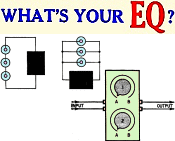 Here is another triplet of mystery circuit
configurations for you to cogitate upon, if you are inclined to cogitate upon such
things. The first one is not too much of a challenge, so don't over-think it. Number
two: Fuggetaboutit, unless you were a television repairman back around 1962 when
this "What's
Your EQ?" feature appeared in Radio-Electronics magazine. Just reading
the description makes my head hurt. Of course this would pose no difficulty for
Mac McGregor. Last but by no means least is the dreaded "black box" problem. I usually
do not fare too well on these. I have the reference Black Box No. 3 issue posted,
but haven't added the images yet. My simplistic solution is to say there is a constant
current source in the black box, but that is not the inventor's intention... Here is another triplet of mystery circuit
configurations for you to cogitate upon, if you are inclined to cogitate upon such
things. The first one is not too much of a challenge, so don't over-think it. Number
two: Fuggetaboutit, unless you were a television repairman back around 1962 when
this "What's
Your EQ?" feature appeared in Radio-Electronics magazine. Just reading
the description makes my head hurt. Of course this would pose no difficulty for
Mac McGregor. Last but by no means least is the dreaded "black box" problem. I usually
do not fare too well on these. I have the reference Black Box No. 3 issue posted,
but haven't added the images yet. My simplistic solution is to say there is a constant
current source in the black box, but that is not the inventor's intention...
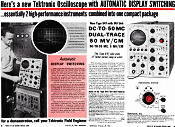 As with a lot of things, when you have been
around test equipment for a long time and new equipment with new features evolve
over time, you might forget how things used to be as you come to take the modern
stuff for granted. Displaying more than one channel's trace at a time is a good
example. When Tektronix introduced the "Automated
Display Switching" feature on their model 547 oscilloscope with the 1A1 time
base plug-in, its ability to show two sweeps simultaneously was ground-breaking.
Prior to that, the user needed to manually switch between input time base units
to get the waveform displayed. Monitoring two waveforms at a time required separate
oscilloscopes, which, given the massive size of their vacuum tube-based... As with a lot of things, when you have been
around test equipment for a long time and new equipment with new features evolve
over time, you might forget how things used to be as you come to take the modern
stuff for granted. Displaying more than one channel's trace at a time is a good
example. When Tektronix introduced the "Automated
Display Switching" feature on their model 547 oscilloscope with the 1A1 time
base plug-in, its ability to show two sweeps simultaneously was ground-breaking.
Prior to that, the user needed to manually switch between input time base units
to get the waveform displayed. Monitoring two waveforms at a time required separate
oscilloscopes, which, given the massive size of their vacuum tube-based...
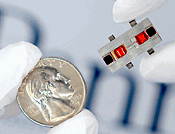 "Engineers from the University of Pennsylvania
School of Engineering and Applied Science have developed an
adjustable filter that can successfully prevent interference, even in higher-frequency
bands of the electromagnetic spectrum. In the early 2010s, LightSquared, a multibillion-dollar
startup promising to revolutionize cellular communications, declared bankruptcy.
The company couldn't figure out how to prevent its signals from interfering with
those of GPS systems. The newly developed adjustable filter could prevent such problems
from ever happening again. "I hope it will enable the next generation of wireless
communications," says Troy Olsson, Associate Professor in Electrical and Systems
Engineering (ESE) at Penn Engineering and the senior author of a new paper in Nature
Communications that describes the filter. The electromagnetic spectrum itself is
one of the modern world's most precious resources..." "Engineers from the University of Pennsylvania
School of Engineering and Applied Science have developed an
adjustable filter that can successfully prevent interference, even in higher-frequency
bands of the electromagnetic spectrum. In the early 2010s, LightSquared, a multibillion-dollar
startup promising to revolutionize cellular communications, declared bankruptcy.
The company couldn't figure out how to prevent its signals from interfering with
those of GPS systems. The newly developed adjustable filter could prevent such problems
from ever happening again. "I hope it will enable the next generation of wireless
communications," says Troy Olsson, Associate Professor in Electrical and Systems
Engineering (ESE) at Penn Engineering and the senior author of a new paper in Nature
Communications that describes the filter. The electromagnetic spectrum itself is
one of the modern world's most precious resources..."
 During my tenure in the early-to-mid 1980s
as an electronics technician at Westinghouse Electric's Oceanic Division, in Annapolis,
Maryland, I assembled many a Mil-Spec printed circuit board. An initial week-long
soldering class and then periodic refreshers were required to get NASA-certified
for the type of critical work we did there. I have written before about the rigid
inspection process that each PCB, cable harness, wire-wrap board, etc., was put
through. Many of the assemblies for use in underwater vehicles and ship-based controllers
needed to be
conformably coated for protection against the corrosive salt water environment.
The first step was usually thorough cleaning in a heated ultrasonic bath of methyl
chloroform (aka 1,1,1-trichloroethane, no citrus-based cleaners in those days),
which not only removed... During my tenure in the early-to-mid 1980s
as an electronics technician at Westinghouse Electric's Oceanic Division, in Annapolis,
Maryland, I assembled many a Mil-Spec printed circuit board. An initial week-long
soldering class and then periodic refreshers were required to get NASA-certified
for the type of critical work we did there. I have written before about the rigid
inspection process that each PCB, cable harness, wire-wrap board, etc., was put
through. Many of the assemblies for use in underwater vehicles and ship-based controllers
needed to be
conformably coated for protection against the corrosive salt water environment.
The first step was usually thorough cleaning in a heated ultrasonic bath of methyl
chloroform (aka 1,1,1-trichloroethane, no citrus-based cleaners in those days),
which not only removed...
 With more than 1000
custom-built symbols, this has got to be the most comprehensive set of
Visio Symbols
available for RF, analog, and digital system and schematic drawings! Every object
has been built to fit proportionally on the provided A-, B- and C-size drawing page
templates (or can use your own). Symbols are provided for equipment racks and test
equipment, system block diagrams, conceptual drawings, and schematics. Unlike previous
versions, these are NOT Stencils, but instead are all contained on tabbed pages
within a single Visio document. That puts everything in front of you in its full
glory. Just copy and paste what you need on your drawing... With more than 1000
custom-built symbols, this has got to be the most comprehensive set of
Visio Symbols
available for RF, analog, and digital system and schematic drawings! Every object
has been built to fit proportionally on the provided A-, B- and C-size drawing page
templates (or can use your own). Symbols are provided for equipment racks and test
equipment, system block diagrams, conceptual drawings, and schematics. Unlike previous
versions, these are NOT Stencils, but instead are all contained on tabbed pages
within a single Visio document. That puts everything in front of you in its full
glory. Just copy and paste what you need on your drawing...
Tuesday the 18th
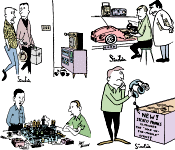 Many of these vintage electronics-theme
comics would fit well into today's "meme" for the "You
know you are old if you remember this" type pictures. There might be a photo
of a dial phone, a car or truck with three pedals under the dashboard (accelerator,
brake and clutch), a phone booth on the street corner, a bicycle with a banana seat
and sissy bar, or maybe a typewriter. The April 1962 issue of Radio-Electronics
magazine includes comics showing a record player (vs. Blu-ray or DVD player), a
set of headphones (vs. ear buds), an electronics chassis filled with vacuum tubes
and leaded components (vs. leadless ICs and passives), and a sports car having a
radio installed (vs. Bluetooth connection for streaming from smartphone). Who among
us remembers adjusting the tone arm on a turntable for optimum tracking and balance?... Many of these vintage electronics-theme
comics would fit well into today's "meme" for the "You
know you are old if you remember this" type pictures. There might be a photo
of a dial phone, a car or truck with three pedals under the dashboard (accelerator,
brake and clutch), a phone booth on the street corner, a bicycle with a banana seat
and sissy bar, or maybe a typewriter. The April 1962 issue of Radio-Electronics
magazine includes comics showing a record player (vs. Blu-ray or DVD player), a
set of headphones (vs. ear buds), an electronics chassis filled with vacuum tubes
and leaded components (vs. leadless ICs and passives), and a sports car having a
radio installed (vs. Bluetooth connection for streaming from smartphone). Who among
us remembers adjusting the tone arm on a turntable for optimum tracking and balance?...
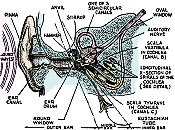 A story in an electronics magazine on the
physics and biology of the human ear is as relevant today as it was in 1936 when
this appeared in Radio-Craft magazine. Back then, creating sound in an
efficient and effective manner for consumer, commercial, and military purposes was
a relatively new science. Thomas Edison introduced his phonograph in 1877. While
it did not feature an
electrically driven speaker, research determined the shape, size, and material
composition of the mechanism that converted minute grooves etched into the surface
of a cylinder into sound pressure great enough for perception. Alexander Graham
Bell's telephone of the same era (1876), used an electromagnetic coil to power a
speaker membrane. 40 years later, radios were appearing everywhere and the race
was on to provide high fidelity sound as a means to differentiate quality models
from lesser models. Much research - the first of its kind - was performed on the
workings of the human in an attempt to quantify its functional parameters... A story in an electronics magazine on the
physics and biology of the human ear is as relevant today as it was in 1936 when
this appeared in Radio-Craft magazine. Back then, creating sound in an
efficient and effective manner for consumer, commercial, and military purposes was
a relatively new science. Thomas Edison introduced his phonograph in 1877. While
it did not feature an
electrically driven speaker, research determined the shape, size, and material
composition of the mechanism that converted minute grooves etched into the surface
of a cylinder into sound pressure great enough for perception. Alexander Graham
Bell's telephone of the same era (1876), used an electromagnetic coil to power a
speaker membrane. 40 years later, radios were appearing everywhere and the race
was on to provide high fidelity sound as a means to differentiate quality models
from lesser models. Much research - the first of its kind - was performed on the
workings of the human in an attempt to quantify its functional parameters...
 "The
IEEE International Microwave Symposium (IMS) will be organizing
Future G Summit this year. The summit will feature four sessions throughout
the day, each focusing on a different theme: Spectrum Co-Existence and Sustainability,
Non-Terrestrial Networks (NTNs), Metaverse Technologies, and 6G Technologies. Each
of the themed sessions will feature speakers from industry describing some of the
interdisciplinary concepts enabling these Future G systems. At the conclusion of
each session, there will be an interactive panel comprising technical experts who
will field questions from the audience and discuss some of the challenges for the
realization of Future G networks..." "The
IEEE International Microwave Symposium (IMS) will be organizing
Future G Summit this year. The summit will feature four sessions throughout
the day, each focusing on a different theme: Spectrum Co-Existence and Sustainability,
Non-Terrestrial Networks (NTNs), Metaverse Technologies, and 6G Technologies. Each
of the themed sessions will feature speakers from industry describing some of the
interdisciplinary concepts enabling these Future G systems. At the conclusion of
each session, there will be an interactive panel comprising technical experts who
will field questions from the audience and discuss some of the challenges for the
realization of Future G networks..."
 A story in an electronics magazine on the
physics and biology of the human ear is as relevant today as it was in 1936 when
this appeared in Radio-Craft magazine. Back then, creating sound in an
efficient and effective manner for consumer, commercial, and military purposes was
a relatively new science. Thomas Edison introduced his phonograph in 1877. While
it did not feature an
electrically driven speaker, research determined the shape, size, and material
composition of the mechanism that converted minute grooves etched into the surface
of a cylinder into sound pressure great enough for perception. Alexander Graham
Bell's telephone of the same era (1876), used an electromagnetic coil to power a
speaker membrane. 40 years later, radios were appearing everywhere and the race
was on to provide high fidelity sound as a means to differentiate quality models
from lesser models. Much research - the first of its kind - was performed on the
workings of the human in an attempt to quantify its functional parameters... A story in an electronics magazine on the
physics and biology of the human ear is as relevant today as it was in 1936 when
this appeared in Radio-Craft magazine. Back then, creating sound in an
efficient and effective manner for consumer, commercial, and military purposes was
a relatively new science. Thomas Edison introduced his phonograph in 1877. While
it did not feature an
electrically driven speaker, research determined the shape, size, and material
composition of the mechanism that converted minute grooves etched into the surface
of a cylinder into sound pressure great enough for perception. Alexander Graham
Bell's telephone of the same era (1876), used an electromagnetic coil to power a
speaker membrane. 40 years later, radios were appearing everywhere and the race
was on to provide high fidelity sound as a means to differentiate quality models
from lesser models. Much research - the first of its kind - was performed on the
workings of the human in an attempt to quantify its functional parameters...
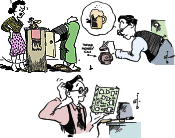 We live in days of plenty of everything.
People throw away and stash away items that our parents - and particularly grandparents
- could only dream of having available. Even households that have never seen a penny
of earned income in decades are overflowing with stuff. Shopping carts in Walmart,
K-Mart, and Target are filled to overflowing when I am there with toys, shoes and
clothes, electronic gadgets, sporting goods, automotive accessories, pet food (Target
has reefers with fresh meat for dogs) and accessories, lawn and garden implements,
hand tools, DVDs and Blu-rays, televisions, disposable diapers (lots of disposable
diapers), snack cakes and crackers, soda, bottles of - get this - water (that costs
as much as soda), ice cream, frozen pizzas and microwaveable dinners, energy bars
and bags of candy. You get the picture. People have so much stuff that one of the
largest areas of the store is the plastic storage bin section - reserve one for
each giant... We live in days of plenty of everything.
People throw away and stash away items that our parents - and particularly grandparents
- could only dream of having available. Even households that have never seen a penny
of earned income in decades are overflowing with stuff. Shopping carts in Walmart,
K-Mart, and Target are filled to overflowing when I am there with toys, shoes and
clothes, electronic gadgets, sporting goods, automotive accessories, pet food (Target
has reefers with fresh meat for dogs) and accessories, lawn and garden implements,
hand tools, DVDs and Blu-rays, televisions, disposable diapers (lots of disposable
diapers), snack cakes and crackers, soda, bottles of - get this - water (that costs
as much as soda), ice cream, frozen pizzas and microwaveable dinners, energy bars
and bags of candy. You get the picture. People have so much stuff that one of the
largest areas of the store is the plastic storage bin section - reserve one for
each giant...
 Banner Ads are rotated in all locations
on the page! RF Cafe typically receives 8,000-15,000 visits each
weekday. RF Cafe
is a favorite of engineers, technicians, hobbyists, and students all over the world.
With more than 17,000 pages in the Google search index, RF Cafe returns in
favorable positions on many types of key searches, both for text and images.
Your Banner Ads are displayed on average 280,000 times per year! New content
is added on a daily basis, which keeps the major search engines interested enough
to spider it multiple times each day. Items added on the homepage often can be found
in a Google search within a few hours of being posted. If you need your company
news to be seen, RF Cafe is the place to be... Banner Ads are rotated in all locations
on the page! RF Cafe typically receives 8,000-15,000 visits each
weekday. RF Cafe
is a favorite of engineers, technicians, hobbyists, and students all over the world.
With more than 17,000 pages in the Google search index, RF Cafe returns in
favorable positions on many types of key searches, both for text and images.
Your Banner Ads are displayed on average 280,000 times per year! New content
is added on a daily basis, which keeps the major search engines interested enough
to spider it multiple times each day. Items added on the homepage often can be found
in a Google search within a few hours of being posted. If you need your company
news to be seen, RF Cafe is the place to be...
Monday the 17th
 This Sams Photofact ad from a 1962 issue
of Radio-Electronics magazine is a good example of why the company's electronics
product service packets were so highly regarded. A couple other competitors came
and went in the decades of the twentieth century, but Sams kept on because of their
reputation. In fact, Sams Technical Publishing is still in business today! By 1962,
the electronics industry was in the beginning stages of transitioning from vacuum
tube amplifiers and rectifiers to solid state equivalents, and from point-to-point
wiring to printed circuits. The illustrations created by Sams artists for point-to-point
component hookups were very high quality, and as can be seen here, those for printed
circuits were equally good. One and two sided PCBs were the rule in the day, and
sweeping curvy trace lines with big round soldering pads were used - partly because
they were easy to create, and because the absence of sharp points eliminated peeling
points... This Sams Photofact ad from a 1962 issue
of Radio-Electronics magazine is a good example of why the company's electronics
product service packets were so highly regarded. A couple other competitors came
and went in the decades of the twentieth century, but Sams kept on because of their
reputation. In fact, Sams Technical Publishing is still in business today! By 1962,
the electronics industry was in the beginning stages of transitioning from vacuum
tube amplifiers and rectifiers to solid state equivalents, and from point-to-point
wiring to printed circuits. The illustrations created by Sams artists for point-to-point
component hookups were very high quality, and as can be seen here, those for printed
circuits were equally good. One and two sided PCBs were the rule in the day, and
sweeping curvy trace lines with big round soldering pads were used - partly because
they were easy to create, and because the absence of sharp points eliminated peeling
points...
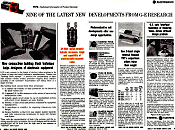 Half a decade after Texas Instruments (Jack
Kilby, 1958) and Fairchild Semiconductor (Robert Noyce, 1960) produced the first
semiconductor integrated circuits, General Electric must not have been too confident
that the newfangled technology was going to take hold. This 2-page spread from a
1964 issue of Electronics magazine, promotes their "Compactron"
integrated circuit vacuum tubes. The Compactron is a building block concept where
standardized stages of diodes, triodes, pentodes, etc., are encapsulated in a single
vacuum tube package with necessary input and output pins for connecting external
components. The incentive was smaller volume, lower parts count, lower power supply
current, simpler chassis wiring or circuit board layout, and greater ruggedness.
One source I found showed the availability in 1962 of 24 distinct Compactron models... Half a decade after Texas Instruments (Jack
Kilby, 1958) and Fairchild Semiconductor (Robert Noyce, 1960) produced the first
semiconductor integrated circuits, General Electric must not have been too confident
that the newfangled technology was going to take hold. This 2-page spread from a
1964 issue of Electronics magazine, promotes their "Compactron"
integrated circuit vacuum tubes. The Compactron is a building block concept where
standardized stages of diodes, triodes, pentodes, etc., are encapsulated in a single
vacuum tube package with necessary input and output pins for connecting external
components. The incentive was smaller volume, lower parts count, lower power supply
current, simpler chassis wiring or circuit board layout, and greater ruggedness.
One source I found showed the availability in 1962 of 24 distinct Compactron models...
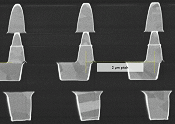 "Researchers at the IEEE Electronic Components
and Technology Conference (ECTC) last week pushed the state of the art in a technology
that is becoming critical to cutting-edge processors and memory. Called
hybrid bonding, the technology
stacks two or more chips atop each other in the same package, allowing chipmakers
to increase the number of transistors in their processors and memories despite a
general slowdown in the pace of the traditional transistor shrinking that once defined
Moore's Law. Research groups from major chipmakers and universities demonstrated
a variety of hard-fought improvements, with a few showing results that could lead
to a record density of connections between 3D stacked chips of around 7 million
links in a square millimeter of silicon. All those connections are needed because
of the new nature of progress in semiconductors, Intel's Yi Shi told engineers at
ECTC..." "Researchers at the IEEE Electronic Components
and Technology Conference (ECTC) last week pushed the state of the art in a technology
that is becoming critical to cutting-edge processors and memory. Called
hybrid bonding, the technology
stacks two or more chips atop each other in the same package, allowing chipmakers
to increase the number of transistors in their processors and memories despite a
general slowdown in the pace of the traditional transistor shrinking that once defined
Moore's Law. Research groups from major chipmakers and universities demonstrated
a variety of hard-fought improvements, with a few showing results that could lead
to a record density of connections between 3D stacked chips of around 7 million
links in a square millimeter of silicon. All those connections are needed because
of the new nature of progress in semiconductors, Intel's Yi Shi told engineers at
ECTC..."
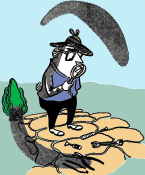 Whilst reading this Carl Kohler technodrama™
entitled "Thin
Air My Foot!," I happened upon this word new to me: 'din,' as in "It was dinned
into me." OK, maybe you already knew that, but surely I should have been aware of
its alternate meaning other than being a loud noise ("the agitated cat made quite
a din"). Fortunately, I am not subject to a household of people who refuse to put
things back in their respective places when through with them, but this tale of
woe tells what might be a familiar scenario to you. To be honest, this could have
been written about me as a boy - before the U.S. Air Force taught me a thing or
two about organization and neatness - since I continually frustrated my father by
leaving his tools (and hardware and lumber and paint) scattered... Whilst reading this Carl Kohler technodrama™
entitled "Thin
Air My Foot!," I happened upon this word new to me: 'din,' as in "It was dinned
into me." OK, maybe you already knew that, but surely I should have been aware of
its alternate meaning other than being a loud noise ("the agitated cat made quite
a din"). Fortunately, I am not subject to a household of people who refuse to put
things back in their respective places when through with them, but this tale of
woe tells what might be a familiar scenario to you. To be honest, this could have
been written about me as a boy - before the U.S. Air Force taught me a thing or
two about organization and neatness - since I continually frustrated my father by
leaving his tools (and hardware and lumber and paint) scattered...
 RF Cascade Workbook is the next phase in the evolution of RF Cafe's long-running
series, RF Cascade Workbook. Chances are you have never used a spreadsheet
quite like this (click
here for screen capture). It is a full-featured RF system cascade parameter
and frequency planner that includes filters and mixers for a mere $45. Built in
MS Excel, using RF Cascade Workbook is a cinch and the format
is entirely customizable. It is significantly easier and faster than using a multi-thousand
dollar simulator when a high level system analysis is all that is needed...
RF Cascade Workbook is the next phase in the evolution of RF Cafe's long-running
series, RF Cascade Workbook. Chances are you have never used a spreadsheet
quite like this (click
here for screen capture). It is a full-featured RF system cascade parameter
and frequency planner that includes filters and mixers for a mere $45. Built in
MS Excel, using RF Cascade Workbook is a cinch and the format
is entirely customizable. It is significantly easier and faster than using a multi-thousand
dollar simulator when a high level system analysis is all that is needed...
These archive pages are provided in order to make it easier for you to find items
that you remember seeing on the RF Cafe homepage. Of course probably the easiest
way to find anything on the website is to use the "Search
RF Cafe" box at the top of every page.
About RF Cafe.
Homepage Archive Pages
2024:
Jan |
Feb |
Mar |
Apr |
May |
Jun |
Jul |
Aug |
Sep |
Oct |
Nov |
Dec
2023:
Jan |
Feb |
Mar |
Apr |
May |
Jun |
Jul |
Aug |
Sep |
Oct |
Nov |
Dec
2022:
Jan |
Feb |
Mar |
Apr |
May |
Jun |
Jul |
Aug |
Sep |
Oct |
Nov |
Dec
2021:
Jan |
Feb |
Mar |
Apr |
May |
Jun |
Jul |
Aug |
Sep |
Oct |
Nov |
Dec
2020:
Jan |
Feb |
Mar |
Apr |
May |
Jun |
Jul |
Aug |
Sep |
Oct |
Nov |
Dec
2019:
Jan |
Feb |
Mar |
Apr |
May |
Jun |
Jul |
Aug |
Sep |
Oct |
Nov |
Dec
2018:
Jan |
Feb |
Mar |
Apr |
May |
Jun |
Jul |
Aug |
Sep |
Oct |
Nov |
Dec
2017:
Jan |
Feb |
Mar |
Apr |
May |
Jun |
Jul |
Aug |
Sep |
Oct |
Nov |
Dec
2016:
Jan |
Feb |
Mar |
Apr |
May |
Jun |
Jul |
Aug |
Sep |
Oct |
Nov |
Dec
2015:
Jan |
Feb |
Mar |
Apr |
May |
Jun |
Jul |
Aug |
Sep |
Oct |
Nov |
Dec
2014:
Jan |
Feb |
Mar |
Apr |
May |
Jun |
Jul |
Aug |
Sep |
Oct |
Nov |
Dec
2013:
Jan |
Feb |
Mar |
Apr |
May |
Jun |
Jul |
Aug |
Sep |
Oct |
Nov |
Dec
2012:
1 |
2 |
3 |
4 |
5 |
6 |
7 |
8 |
9 |
10 |
11 |
12 |
13 (no archives before 2012)
|












































 We live in days of plenty of everything
We live in days of plenty of everything




